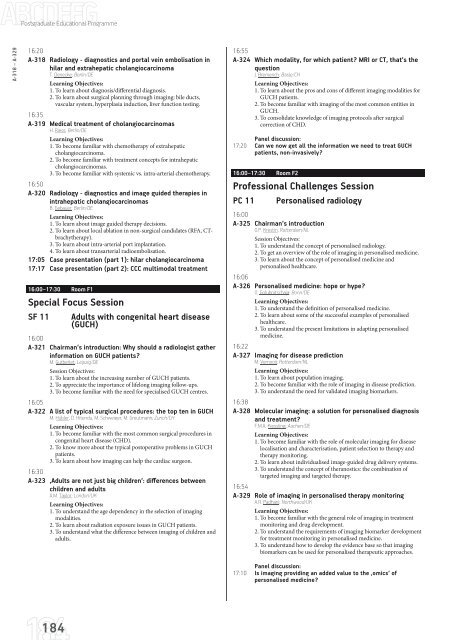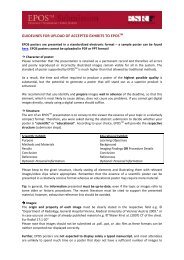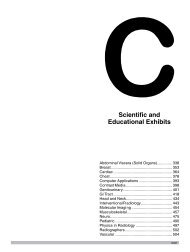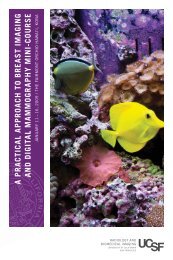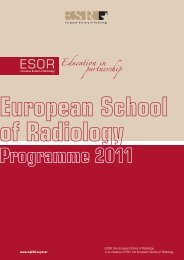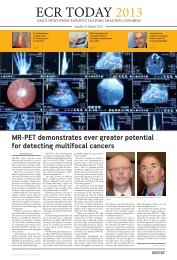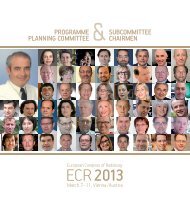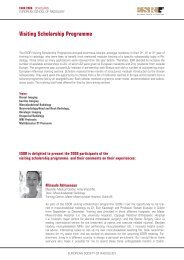ECR 2013 â Final Programme - myESR.org
ECR 2013 â Final Programme - myESR.org
ECR 2013 â Final Programme - myESR.org
- No tags were found...
You also want an ePaper? Increase the reach of your titles
YUMPU automatically turns print PDFs into web optimized ePapers that Google loves.
Postgraduate Educational <strong>Programme</strong>A-318 – A-32916:20A-318 Radiology - diagnostics and portal vein embolisation inhilar and extrahepatic cholangiocarcinomaT. Denecke; Berlin/DELearning Objectives:1. To learn about diagnosis/differential diagnosis.2. To learn about surgical planning through imaging: bile ducts,vascular system, hyperplasia induction, liver function testing.16:35A-319 Medical treatment of cholangiocarcinomasH. Riess; Berlin/DELearning Objectives:1. To become familiar with chemotherapy of extrahepaticcholangiocarcinoma.2. To become familiar with treatment concepts for intrahepaticcholangiocarcinomas.3. To become familiar with systemic vs. intra-arterial chemotherapy.16:50A-320 Radiology - diagnostics and image guided therapies inintrahepatic cholangiocarcinomasB. Gebauer; Berlin/DELearning Objectives:1. To learn about image guided therapy decisions.2. To learn about local ablation in non-surgical candidates (RFA, CTbrachytherapy).3. To learn about intra-arterial port implantation.4. To learn about transarterial radioembolisation.17:05 Case presentation (part 1): hilar cholangiocarcinoma17:17 Case presentation (part 2): CCC multimodal treatment16:00–17:30 Room F1Special Focus SessionSF 11 Adults with congenital heart disease(GUCH)16:00A-321 Chairman‘s introduction: Why should a radiologist gatherinformation on GUCH patients?M. Gutberlet; Leipzig/DESession Objectives:1. To learn about the increasing number of GUCH patients.2. To appreciate the importance of lifelong imaging follow-ups.3. To become familiar with the need for specialised GUCH centres.16:05A-322 A list of typical surgical procedures: the top ten in GUCHM. Hübler, D. Hitendu, M. Schweiger, M. Greutmann; Zurich/CHLearning Objectives:1. To become familiar with the most common surgical procedures incongenital heart disease (CHD).2. To know more about the typical postoperative problems in GUCHpatients.3. To learn about how imaging can help the cardiac surgeon.16:30A-323 ‚Adults are not just big children‘: differences betweenchildren and adultsA.M. Taylor; London/UKLearning Objectives:1. To understand the age dependency in the selection of imagingmodalities.2. To learn about radiation exposure issues in GUCH patients.3. To understand what the difference between imaging of children andadults.16:55A-324 Which modality, for which patient? MRI or CT, that‘s thequestionJ. Bremerich; Basle/CHLearning Objectives:1. To learn about the pros and cons of different imaging modalities forGUCH patients.2. To become familiar with imaging of the most common entities inGUCH.3. To consolidate knowledge of imaging protocols after surgicalcorrection of CHD.Panel discussion:17:20 Can we now get all the information we need to treat GUCHpatients, non-invasively?16:00–17:30 Room F2Professional Challenges SessionPC 11 Personalised radiology16:00A-325 Chairman‘s introductionG.P. Krestin; Rotterdam/NLSession Objectives:1. To understand the concept of personalised radiology.2. To get an overview of the role of imaging in personalised medicine.3. To learn about the concept of personalised medicine andpersonalised healthcare.16:06A-326 Personalised medicine: hope or hype?O. Golubnitschaja; Bonn/DELearning Objectives:1. To understand the definition of personalised medicine.2. To learn about some of the successful examples of personalisedhealthcare.3. To understand the present limitations in adapting personalisedmedicine.16:22A-327 Imaging for disease predictionM. Vernooij; Rotterdam/NLLearning Objectives:1. To learn about population imaging.2. To become familiar with the role of imaging in disease prediction.3. To understand the need for validated imaging biomarkers.16:38A-328 Molecular imaging: a solution for personalised diagnosisand treatment?F.M.A. Kiessling; Aachen/DELearning Objectives:1. To become familiar with the role of molecular imaging for diseaselocalisation and characterisation, patient selection to therapy andtherapy monitoring.2. To learn about individualised image-guided drug delivery systems.3. To understand the concept of theranostics: the combination oftargeted imaging and targeted therapy.16:54A-329 Role of imaging in personalised therapy monitoringA.R. Padhani; Northwood/UKLearning Objectives:1. To become familiar with the general role of imaging in treatmentmonitoring and drug development.2. To understand the requirements of imaging biomarker developmentfor treatment monitoring in personalised medicine.3. To understand how to develop the evidence base so that imagingbiomarkers can be used for personalised therapeutic approaches.Panel discussion:17:10 Is imaging providing an added value to the ‚omics‘ ofpersonalised medicine?184


